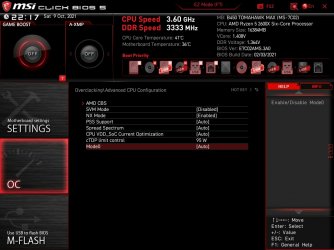- Joined
- Nov 15, 2021
- Messages
- 16 (0.01/day)
| Processor | AMD Ryzen 7 5800X |
|---|---|
| Motherboard | Asus X570i |
| Cooling | EKWB 240 AIO |
| Memory | 2x8gb 3200 Mhz |
| Video Card(s) | AMD Midnight Black 6800XT |
| Storage | 970 evo, 980 pro, 840 evo |
| Display(s) | DELL S2719DGF |
| Case | iQunix ZX-1 |
| Power Supply | Corsair SF 750 |
| Mouse | Logitech G Pro Wireless |
| Keyboard | Cooler Master Masterkeys Pro S |
Was tempted to react to one of the many existing 5800x undervolting/overclocking/PBO guides or discussions but I have not seen this question before:
Is it currently possible to set a limit to PBO's maximum boost frequency? A manual negative frequency offset if you will?
My 'issue' is the following: when using PBO, with curve optimizer set manually, tested and everything, with PPT110, TDC75 and EDC95, in mixed-load usage (gaming, opening 20 new tabs/opening the browser, using CAD) the CPU will try to perform a temporary boost to 4.8, sometimes even 4.85Ghz, with an SoC SV12 voltage of 1.425-1.45, causing temps to go higher (to 85-89 celsius) than in the cinebench all core synthetic load where it will settle at 4.55-4.6Ghz @ ~1.38V. This results in an average CR20 score of roughly 6000, CR23 of around 15k, staying below 76 degrees. I realize these voltages are the maximum read values but I am no voltage expert, even with a polling period of 100ms on HWinfo the 1.38V seems to be relatively constant.
Disabling 'core performance boost' in the bios stops PBO from working, I suspect there is no workaround for this? To my knowledge they are not the same? It stops the processor from 'boosting' above 3.8Ghz, PPT never hits >70W and CR20 reaches an average of ~4800.
Hard locking the voltage and frequency ratio to 1.275 and 44x would be fine if it weren't for the high idle wattage that is a result of that.
Is it possible to have all the good things? My aim is to limit the maximum boost frequency to 4.6Ghz.
Am using Asus X570i, latest bios, EKWB 240 AIO. Maybe @Mussels can help, as he has an Asus motherboard and I saw him mentioning the boost behaviour to 4.8+Ghz while gaming.
Is it currently possible to set a limit to PBO's maximum boost frequency? A manual negative frequency offset if you will?
My 'issue' is the following: when using PBO, with curve optimizer set manually, tested and everything, with PPT110, TDC75 and EDC95, in mixed-load usage (gaming, opening 20 new tabs/opening the browser, using CAD) the CPU will try to perform a temporary boost to 4.8, sometimes even 4.85Ghz, with an SoC SV12 voltage of 1.425-1.45, causing temps to go higher (to 85-89 celsius) than in the cinebench all core synthetic load where it will settle at 4.55-4.6Ghz @ ~1.38V. This results in an average CR20 score of roughly 6000, CR23 of around 15k, staying below 76 degrees. I realize these voltages are the maximum read values but I am no voltage expert, even with a polling period of 100ms on HWinfo the 1.38V seems to be relatively constant.
Disabling 'core performance boost' in the bios stops PBO from working, I suspect there is no workaround for this? To my knowledge they are not the same? It stops the processor from 'boosting' above 3.8Ghz, PPT never hits >70W and CR20 reaches an average of ~4800.
Hard locking the voltage and frequency ratio to 1.275 and 44x would be fine if it weren't for the high idle wattage that is a result of that.
Is it possible to have all the good things? My aim is to limit the maximum boost frequency to 4.6Ghz.
Am using Asus X570i, latest bios, EKWB 240 AIO. Maybe @Mussels can help, as he has an Asus motherboard and I saw him mentioning the boost behaviour to 4.8+Ghz while gaming.
Last edited:







